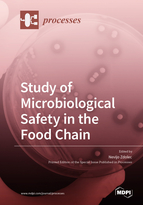Study of Microbiological Safety in the Food Chain
A special issue of Processes (ISSN 2227-9717). This special issue belongs to the section "Food Process Engineering".
Deadline for manuscript submissions: closed (30 November 2021) | Viewed by 31788
Special Issue Editor
Interests: meat safety; foodborne pathogens; antimicrobials; food safety systems
Special Issues, Collections and Topics in MDPI journals
Special Issue Information
Dear Colleagues,
The complex agri-food chain in different cultures may be accompanied with specific and unknown microbial hazards and risk. Therefore, strict microbiological risk assessment of emerging and novel pathogens in animal–human–environment interactions is strongly needed today.
The microbiological safety of food relies on the effectiveness of specific hygienic procedures and technological processes. The concept of food safety has changed in recent years from a hazard- to a risk-based approach coupled with targeted preventive interventions along the food chain. The process from food production to consumption may be very challenging from a microbiological point of view. In that sense, this Special Issue on the “Study of Microbiological Safety in the Food Chain” will give a broad view to available tools and process interventions to combat traditional and potential microbiological hazards within the whole agri-food chain.
Potential topics include but are not limited to the following:
- Food safety assurance systems;
- Epidemiology of foodborne pathogens;
- Microbiological risk assessment in food safety;
- On-farm food safety;
- Emerging pathogens in food chain;
- Food processing hygiene and microbiological food safety;
- Effect of food processing methods on foodborne pathogens;
- Reduction of hazardous microbial metabolites in food;
- Thermal and non-thermal inactivation of microbes in food;
- Challenge tests;
- Bio-preservation and hurdle technology;
- Beneficial microbes in food;
- Antimicrobial capacity of natural compounds in food;
- Traditional and industrial food production: microbiological risk.
Dr. Nevijo Zdolec
Guest Editor
Manuscript Submission Information
Manuscripts should be submitted online at www.mdpi.com by registering and logging in to this website. Once you are registered, click here to go to the submission form. Manuscripts can be submitted until the deadline. All submissions that pass pre-check are peer-reviewed. Accepted papers will be published continuously in the journal (as soon as accepted) and will be listed together on the special issue website. Research articles, review articles as well as short communications are invited. For planned papers, a title and short abstract (about 100 words) can be sent to the Editorial Office for announcement on this website.
Submitted manuscripts should not have been published previously, nor be under consideration for publication elsewhere (except conference proceedings papers). All manuscripts are thoroughly refereed through a single-blind peer-review process. A guide for authors and other relevant information for submission of manuscripts is available on the Instructions for Authors page. Processes is an international peer-reviewed open access monthly journal published by MDPI.
Please visit the Instructions for Authors page before submitting a manuscript. The Article Processing Charge (APC) for publication in this open access journal is 2400 CHF (Swiss Francs). Submitted papers should be well formatted and use good English. Authors may use MDPI's English editing service prior to publication or during author revisions.
Keywords
- Food chain
- Hygiene and technology
- Emerging foodborne pathogens
- Toxic microbial metabolites
- Risk assessment
- Food processing
- Interventions
- Microbial inactivation
- Beneficial microbes
- Natural compounds






